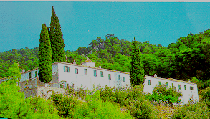|
|
|
|
Poros' Attractions |
|
The Monastery is located about four kilometers from the TownCenter
and it was erected between 1713 to 1734 by the Metropolite of Athens, Iakovos
the Second. It is said that the Metropolite erected the Monastery because
he  was suffering
from lithiasis and when he drank from the natural spring, outside the monastery,
he got well.
was suffering
from lithiasis and when he drank from the natural spring, outside the monastery,
he got well.
The Church that is built inside the Monastery is dedicated to the "Zoodochou Pigis" and many heroes of the Greek revolution have been buried at the Monastery's yard. One of the them is the known admiral Manolis Tobazis.
Furthermore, the daughter of the Italian painter Raphael Ceccholi, who is also resting at the yard, was the artist's inspiration when he painted the beautiful icon of the Virgin Mary in 1850.
The Lemon Tree Forest, one of the many tourist attractions of Poros, has been the inspiration for many poets and authors. Diagonally across from the center of Poros, the Lemon Tree Forest is lying at the mountainside of "Aderes," and it is a must for the tourist.
As the title suggests this a forest exclusively with lemon trees, not too far from one of the most beautiful beaches of the surrounding area (Aliki Beach). As the visitor approaches the forest he/she is overcome by the strong and refreshing scent of the lemon trees.
A small but traditional taverna (Kardasis) welcomes the visitor who can listen to the sounds of the running water and enjoy a freshly squeezed lemonade while watching Poros unfold underneath his feet.
The elevation where the taverna is located, almost half way up to the forest, offers one of the most beautiful views of Poros and its surrounding areas. As a matter of fact, on a clear afternoon one can even see the island of Aegina.
It is located almost at the center of the island and myth has it that Poseidon exchanged his Temple at Delphi with the one that Apollon had at Kalavria in Poros. Poseidon's temple is of the Dorian order and it has six columns on its short side and 12 columns on its long side (27,40X14,40). The exact date that it was built is uncertain. The year 520 BC is claimed by N. Faraklas, although I. Stamatiou claims that it was built around the 6th century BC, and still others claim that it was built much earlier.
According to Giannis Poulakis, in his book Poros and Its History (p. 43), "Poseidon's Temple soon developed into a prestigious and Panhellenic place of worship and became a center where many Hellenic cities founded the first and most powerful in the Hellenic world amphictyony*".
The amphictyony of Kalavria consisted of seven cities. After the dissolution of the amphictyony which is estimated to have occurred around the 5th century BC, Poseidon's Temple continued to be a place of worship.
Although it still survives, Poseidon's Temple has been pillaged from the statues that it once had. For example what remains from Poseidon's statue (estimated to be about 5 meters in height) is the foot of the statue (about 70 centimeters long), which is stored in Poros' Museum.
*Amphictyony is a political and cultural association among cities with a common Temple of worship.
In 1770 when Russia and Turkey were at war, a Russian Navy flotilla visited the Aegean under the leadership of Alexi Orlof. Following a series of unsuccessful battles in the Aegean and losing the naval battle in Limnos, Orlof ordered his frigate and the rest of the flotilla to retreat towards Italy. However, the Greek crews pleaded with him and convinced him to stay and continue the fight. Orlof changing his mind decided to set up his command post in the naturally protected harbor of Poros.
In 1834, the Greek State bought the Russian installations at Poros and founded the First Naval base of Greece. However, during the same year Russia decided to built new installations (warehouses) a few kilometers away from its old base, at the present point of the ruins of the Russian Naval Base, which is across the picturesque islet of "Daskaleio."
|
For suggestions, corrections or
comments regarding this web site please contact the webmaster |